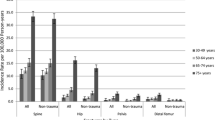Abstract
Summary
We studied factors to determine the receipt of osteoporosis treatment in individuals with osteoporosis. Treatment was associated with age, gender, race, body mass index (BMI), family history, arthritis and thyroid problems, daily glucocorticoid use, number of prescriptions and healthcare visits, and insurance type.
Introduction
Osteoporosis is underrecognized and undertreated. Few studies have examined factors associated with osteoporosis treatment in a large, national sample of men and women.
Methods
We aggregated National Health and Nutrition Examination Survey (NHANES) data from 2005 to 2010 and created a subsample which included individuals 50 years or older who were identified to have osteoporosis either by self-report data or by bone density measurements. The primary outcome was the receipt of osteoporosis treatment either from self-report or from prescription records. Covariates included sociodemographics, clinical characteristics, and access to healthcare variables. Logistic regression analyses were performed to determine factors that associate with osteoporosis treatment.
Results
From a sample of 31,0134 participants, 1,133 subjects (3.65 %) met the study criteria. Treatment was associated with age (odds ratio (OR) = 1.14), gender (OR = 13.25), race (OR = 2.23, White vs. Black; OR = 1.76, other vs. Black), BMI (OR = 1.67, normal vs. obese; OR = 2.68, overweight vs. obese), family history of osteoporosis (OR = 1.94), arthritis (OR = 1.43), daily glucocorticoid use (OR = 1.43), number of prescriptions (OR = 1.01), and number of healthcare visits in the past year (OR = 1.44, 4–9 vs. 0–3 visits). All odds ratios were statistically significant.
Conclusion
A large number of individuals diagnosed with osteoporosis above the age of 50 remain untreated. It is important for healthcare providers to better assess older adults with osteoporosis, including individuals who frequently receive medical care.

Similar content being viewed by others
References
Consensus Development Conference (1993) Consensus development conference: diagnosis, prophylaxis, and treatment of osteoporosis. Am J Med 94:646–650
National Osteoporosis Foundation (2013) The NOF releases new data detailing the prevalence of osteoporosis. http://www.nof.org/news/1009. Accessed 1 December 2013
National Osteoporosis Foundation (2013) Clinician’s guide to prevention and treatment of osteoporosis. National Osteoporosis Foundation. http://nof.org/files/nof/public/content/resource/913/files/580.pdf. Accessed 1 December 2013
Brennan RM, Wactawski-Wende J, Crespo CJ, Dmochowski J (2004) Factors associated with treatment initiation after osteoporosis screening. Am J Epidemiol 160:475–483
International Osteoporosis Foundation (2013) Facts and statistics. International Osteoporosis Foundation. http://www.iofbonehealth.org/facts-statistics. Access 1 December 2013
Sutton A, Dian L, Guy P (2011) Osteoporosis in men: an underrecognized and undertreated problem. BCMJ 53(10):535–540
DeJesus RS, Chaudhry R, Angstman KB, Cha SS, Tulledge-Scheitel SM, Kesman RL, Bernard ME, Stroebel RJ (2011) Predictors of osteoporosis screening completion rates in a primary care practice. Popul Health Manag 14:243–247
Nayak S, Roberts MS, Greenspan SL (2009) Factors associated with osteoporosis screening and recommendations for osteoporosis screening in older adults. J Gen Intern Med 24:585–591
Davisson L, Warden M, Manivannan S, Kolar M, Kincaid C, Bashir S, Layne R (2009) Osteoporosis screening: factors associated with bone mineral density testing of older women. J Womens Health (Larchmt) 18:989–994
Ward MA, Xu Y, Viswanathan HN, Stolshek BS, Clay B, Adams JL, Kallich JD, Fine S, Saag KG (2013) Association between osteoporosis treatment change and adherence, incident fracture, and total healthcare costs in a Medicare Advantage Prescription Drug plan. Osteoporos Int 24:1195–1206
Greenspan SL, Wyman A, Hooven FH et al (2012) Predictors of treatment with osteoporosis medications after recent fragility fractures in a multinational cohort of postmenopausal women. J Am Geriatr Soc 60:455–461
National Health and Nutrition Examination Survey (2013) About the National Health and Nutrition Examination Survey. Centers for Disease Control and Prevention. http://www.cdc.gov/nchs/nhanes/about_nhanes.htm. Accessed 1 December 2013
Kanis JA, McCloskey EV, Johansson H, Oden A, Melton LJ 3rd, Khaltaev N (2008) A reference standard for the description of osteoporosis. Bone 42:467–475
The International Society for Clinical Densitometry 2013 Official Positions. http://www.iscd.org/official-positions/2013-iscd-official-positions-adult/
Hosmer DW, Lemeshow S (1989) Applied logistic regression. Wiley, New York
Meadows ES, Mitchell BD, Bolge SC, Johnston JA, Col NF (2012) Factors associated with treatment of women with osteoporosis or osteopenia from a national survey. BMC Womens Health 12:1
Looker CA, Borrud LG, Dawson-Hughes B, Shepherd JA, Wright NC (2012) Osteoporosis or low bone mass at the femur neck or lumbar spine in older adults: United States, 2005–2008. NCHS Data Brief No. 93 http://www.cdc.gov/nchs/data/databriefs/db93.pdf
Curtis JR, McClure LA, Delzell E, Howard VJ, Orwoll E, Saag KG, Safford M, Howard G (2009) Population-based fracture risk assessment and osteoporosis treatment disparities by race and gender. J Gen Intern Med 24(8):956–62
Solomon DH, Morris C, Cheng H, Cabral D, Katz JN, Finkelstein JS, Avorn J (2005) Medication use patterns for osteoporosis: an assessment of guidelines, treatment rates, and quality improvement interventions. Mayo Clin Proc 80(2):194–202
McLeod KM, Johnson CS (2011) A systematic review of osteoporosis health beliefs in adult men and women. J Osteoporosis 2011:197454
Wardlaw GM (1996) Putting body weight and osteoporosis into perspective. Am J Clin Nutr 63:433s–436s
Conflicts of interest
This work received no funding. Tina D. Cunningham, Brian S. Di Pace, and Jagdeesh Ullal declare that they have no conflict of interest concerning this work.
Author information
Authors and Affiliations
Corresponding author
Rights and permissions
About this article
Cite this article
Cunningham, T.D., Di Pace, B.S. & Ullal, J. Osteoporosis treatment disparities: a 6-year aggregate analysis from national survey data. Osteoporos Int 25, 2199–2208 (2014). https://doi.org/10.1007/s00198-014-2747-9
Received:
Accepted:
Published:
Issue Date:
DOI: https://doi.org/10.1007/s00198-014-2747-9




